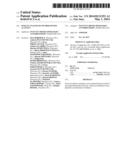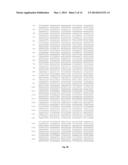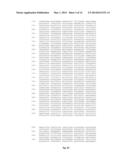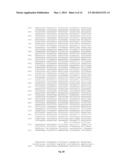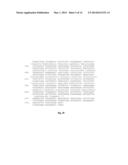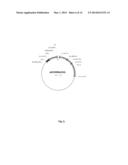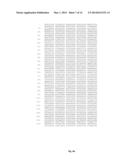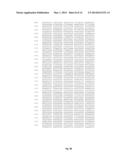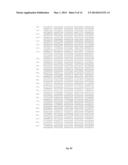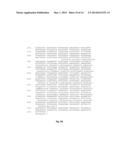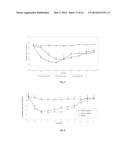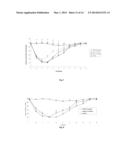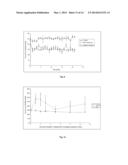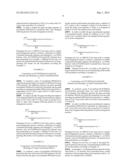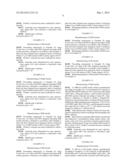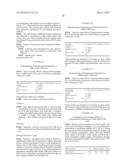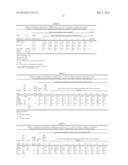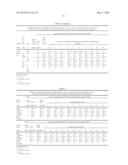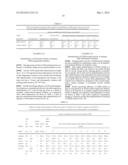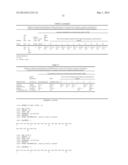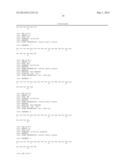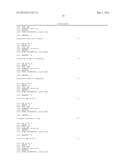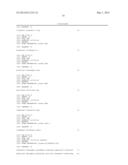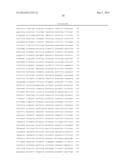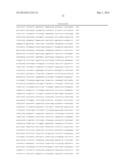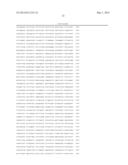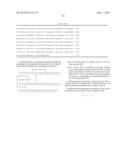Patent application title: INSULIN ANALOGUES OF PROLONGED ACTIVITY
Inventors:
Piotr Borowicz (Warszawa, PL)
Andrzej Plucienniczak (Warszawa, PL)
Jerzy Mikolajczyk (Warszawa, PL)
Tadeusz Glabski (Warszawa, PL)
Dariusz Kurzynoga (Warszawa, PL)
Diana Mikiewicz-Sygula (Warszawa, PL)
Anna Wojtowicz-Krawiec (Warszawa, PL)
Marcin Zielinski (Warszawa, PL)
Malgorzata Kesik-Brodacka (Warszawa, PL)
Violetta Adamczewska-Cecuda (Warszawa, PL)
Iwona Sokolowska (Warszawa, PL)
Grazyna Plucienniczak (Warszawa, PL)
Dorota Stadnik (Warszawa, PL)
Jaroslaw Antosik (Skierniewice, PL)
Jacek Pstrzoch (Warszawa, PL)
Justyna Bernat (Warszawa, PL)
Wojciech Slawinski (Warszawa, PL)
Tomasz Pawlukowiec (Deszno, PL)
Jacek Stepniewski (Plock, PL)
Monika Bogiel (Pruszkow, PL)
Assignees:
INSTYTUT BIOTECHNOLOGII I ANTYBIOTYKOW
IPC8 Class: AC07K1462FI
USPC Class:
530304
Class name: Peptides of 3 to 100 amino acid residues insulin; related peptides metal complexes, e.g., zn-insulin, etc.
Publication date: 2014-05-01
Patent application number: 20140121353
Abstract:
New biosynthetic analogues of recombined human insulin of prolonged
therapeutical activity, which can find place in prophylactic and
treatment of diabetes.Claims:
1. Insulin derivative or its pharmaceutically acceptable salt containing
two polypeptides forming chain A and chain B, characterised by being a
new polypeptide of formula 1: ##STR00003## where R denotes group of
formula Asn-R2, where R2 denotes group NH2; and R1
denotes B31 Lys-B32Arg or B31Arg, wherein amino acid sequence of chain A
is SEQ ID NO: 4, while amino acid sequence of chain B has been chosen
form SEQ ID NO: 7 and 9, and wherein the new polypeptide of formula 1 is
an analogue of recombined human insulin of isoelectric point 5-8.5.
2. Pharmaceutical composition, characterised in that it contains effectively acting amount of insulin derivative or its pharmaceutically acceptable salt according to claim 1.
3. Pharmaceutical composition according to claim 2, characterised in that it contains 10 up to 50 μg/ml of zinc.
Description:
CROSS REFERENCE TO RELATED APPLICATIONS
[0001] This Application is a divisional of U.S. application Ser. No. 13/002,520 filed Feb. 10, 2011, which is a U.S. National Stage of International PCT Application No. PCT/PL2009/050010 filed Jul. 4, 2009, which claims benefit of the Poland Application No. PL385586 filed Jul. 4, 2008. All of these US and PCT applications are hereby incorporated herein by reference in their entirety.
SUMMARY
[0002] The subjects of the invention are new biosynthetic analogues of recombined human insulin of prolonged therapeutic activity, which may find use in prophylaxis and treatment of diabetes mellitus.
[0003] Insulin and its various derivatives are used in large amounts in treatments of diabetes mellitus and are often manufactured on a large industrial scale. While there are many different known modified derivatives of insulin and many pharmaceutical preparations of diverse activity profiles, a drug is still sought, which would enable to maintain a constant level of glucose in a human organism for an extended period of time.
[0004] To achieve the effect of delayed and/or prolonged activity some preparations of normal human insulin contain specific additions, e.g. various amounts of protamin, a protein that forms an insoluble complex with insulin which forms deposits in subcutaneous tissues, and from which insulin is gradually released.
[0005] There are known various human insulin derivatives used in treatment of diabetes, which contain additional amino acids or have modified sequence of some amino acids. Changes of primary structure of insulin influence its secondary and tertiary structure, which affects protein's chemical and biological properties, and that in turn results in pharmacokinetic and pharmacodynamic effects. These changes are of different character, can lead to accelerated or delayed and prolonged activity of modified insulin. Active form of insulin is a monomer, which easily filters into blood after subcutaneous injection. It is known, that exogenous human insulin in solutions has hexameric form, which after application dissociates to dimers and subsequently to monomers before filtering into blood stream. One of insulin derivatives characterised by accelerated activity is lispro-insulin (Humalog®), in which the sequence of proline (28)-lysine (29) in chain B has been inverted. It makes difficult, from the sterical point, to form dimers of insulin in a solution. Second such a derivative is insulin in which proline in the position 28 of chain B has been replaced with aspartic acid. Such introduced negative charge lowers possibility of self-association of insulin monomers. Both these insulin derivatives are absorbed faster due to their structure.
[0006] Prolonged-activity recombined human insulin analogues are constructed by elongating chain B with alkaline amino acids or acylating E-amino group in lysine in chain B with aliphatic acid of about a dozen carbon atoms.
[0007] Introduction of these extra alkaline amino acids changes some chemical or physical properties of insulin. The most important change is a shift of isoelectric point in respect to unmodified natural insulin from 5.4 to the range of about 5.5 to about 8.5, which results from introduction of superfluous positive charges into the molecule. In consequence solubility of these analogues in neutral water environment is reduced, and therefore necessity of using slightly acidic environment for production of pharmaceutical preparations containing such modified insulin.
[0008] However, beside obvious advantages resulting from introduction of extra alkaline amino acids there is observed also disadvantageous reduction of stability of new analogues, stemming primarily from deamination of asparagine in position A21 occurring in acidic environment.
[0009] This issue is addressed by replacement of A21Asn with other amino acid, such as aspartic acid, glycine, alanine, threonine and others. One of such analogues is recombinant human insulin derivative in which in chain A asparagine(21) has been replaced with glycine(21) and to the C terminus of chain B have been attached two arginine residues. This is so-called glargine derivative of insulin, manufactured under the name Lantus (patent U.S. Pat. No. 5,656,722).
[0010] In the course of our research it has been established, that a human insulin derivative, where to the C terminus of chain B have been attached residues of lysine (B31Lys) and arginine (B32Arg) shows biological activity that is similar to glargine derivative, which is already present on the market. Preliminary research performed on animals indicates, that this preparation, called lizarginsulin, is characterised by prolonged activity and a flat release profile mimicking secretion of natural insulin, and from a clinical point of view--reduction of nocturnal hypoglycaemias. Because of exceptional similarity to human insulin and also to proinsulin, there could be expected good research results, enabling gradual development of the drug candidate and its final commercialisation. It is crucial, that LysArg sequence at C terminus of chain B of human insulin is found in human proinsulin, and one should expect transformation of lizarginsulin into human insulin by present carboxypeptidase C. This means, that first metabolite of lizarginsulin in human organism can be human insulin of well known and acceptable characteristics, even in the case of exogenous hormone. There was performed extended pre-clinical research on rats, which confirmed prolonged activity of the new insulin analogue.
[0011] However it came out that this derivative apart of its advantageous biological activity is characterised by insufficient stability in acidic injection solutions. The main cause of insufficient stability, which manifests itself primarily as deamidation, is presence of asparagine residue at C terminus of chain A, where in acidic water environment can occur a deamidation autocatalysed by a proton from carboxyl group.
[0012] Therefore the aim of this invention is providing new analogues of insulin, which would be characterised by an adequate stability in acidic injection solutions (pH 3.5-5), and at the same time would possess the required biological activity. It is especially desirable that they would show characteristics of biological activity of natural insulin. It is also particularly important, that the start of activity of the new derivatives was practically immediate, just after administration to the patient, with the ability of prolonged release of a part of the dose. This would enable to provide both accelerated and prolonged activity of the pharmaceutical preparation containing insulin analogues.
[0013] The above stated goal was unexpectedly achieved in this invention.
[0014] The basic aspect of the invention is an insulin derivative or its pharmaceutically acceptable salt containing two polypeptides constituting chain A and chain B, where amino acid sequence of chain A has been chosen from SEQ ID No 1-5, while amino acid sequence of chain B has been chosen from SEQ ID No 6-8. Preferred insulin derivative or its pharmaceutically acceptable salt according to the invention is characterised by being an analogue of recombined human insulin of isoelectric point 5-8.5 and formula 1:
##STR00001##
where R denotes an NH2 group or a group according to formula Asn-R2, where R2 denotes a neutral L-amino acid or an NH2 group; and R1 denotes B31Lys-B32Arg or B31Arg-B32Arg or B31Arg, where B3Asn may be alternatively replaced by other amino acid, advantageously by Glu.
[0015] Advantageously, the insulin derivative or its physiologically acceptable salt according to the invention is characterised by this, that:
[0016] R in the formula 1 denotes group of formula Asn-R2, wherein R2 denotes Gly and R1 denotes B31 Lys-B32Arg, or
[0017] R in the formula 1 denotes group of formula Asn-R2, wherein R2 denotes Ala and R1 denotes B31 Lys-B32Arg or
[0018] R in the formula 1 denotes group of formula Asn-R2, wherein R2 denotes Ser and R1 denotes B31 Lys-B32Arg, or
[0019] R in the formula 1 denotes group of formula Asn-R2, wherein R2 denotes Thr and R1 denotes B31 Lys-B32Arg, or
[0020] R in the formula 1 denotes group of formula Asn-R2, wherein R2 denotes group NH2 and R1 denotes B31 Lys-B32Arg, or
[0021] R in the formula 1 denotes group NH2 and R1 denotes B31 Lys-B32Arg, or
[0022] R in the formula 1 denotes group of formula Asn-R2, wherein R2 denotes Gly a R1 denotes B31Arg-B32Arg, or
[0023] R in the formula 1 denotes group of formula Asn-R2, wherein R2 denotes Ala a R1 denotes B31Arg-B32Arg, or
[0024] R in the formula 1 denotes group of formula Asn-R2, wherein R2 denotes Thr a R1 denotes B31Arg-B32Arg, or
[0025] R in the formula 1 denotes group of formula Asn-R2, wherein R2 denotes Ser a R1 denotes B31Arg-B32Arg, or
[0026] R in the formula 1 denotes group of formula Asn-R2, wherein R2 denotes group NH2 and R1 denotes B31Arg-B32Arg, or
[0027] R in the formula 1 denotes group NH2 a R1 denotes B31Arg-B32Arg, or
[0028] R in the formula 1 denotes group of formula Asn-R2, wherein R2 denotes Gly a R1 denotes B31Arg, or p0 R in the formula 1 denotes group of formula Asn-R2, wherein R2 denotes Ala a R1 denotes B31 Arg, or
[0029] R in the formula 1 denotes group of formula Asn-R2, wherein R2 denotes Thr a R1 denotes B31Arg, or
[0030] R in the formula 1 denotes group of formula Asn-R2, wherein R2 denotes Ser a R1 denotes B31Arg, or
[0031] R in the formula 1 denotes group of formula Asn-R2, wherein R2 denotes group NH2 and R1 denotes B31Arg, or
[0032] R in the formula 1 denotes group NH2 a R1 denotes B31Arg, or
[0033] R in the formula 1 denotes group of formula Asn-R2, wherein R2 denotes Gly, R1 denotes B31 Lys-B32Arg, and B3Asn has been replaced with B3Glu.
[0034] As described before, in the case of glargin the problem of low stability has been solved by replacing asparagine in the position A21 with glycine. Research, which aimed at obtaining an insulin analogue exhibiting prolonged activity and stability in acidic injection solutions as described in the invention, went in different direction. In order to block carboxyl group responsible for low stability, there were obtained new derivatives of lizarginsulin with carboxyl group in asparagine residue modified in different ways, using methods of genetic engineering and enzymatic transformation. As a result of the conducted research it unexpectedly turned out, that chemical and biological properties, similar to these of glargine and lizargine derivative, are exhibited by derivatives of human insulin of formula 1, where chain A has been elongated at C terminus with a residuum of neutral amino acid (A22) or where carboxyl group of asparagine or cysteine at C terminus of chain A has been transformed into carboxyamid group, and to the C terminus of chain B there were attached residues of lysine and arginine (B31Lys-B32Arg), or two arginine residues (B31Arg-B32Arg), or one arginine residue (B31Arg). New analogues obtained in such a way are characterised by proper stability in acidic injection solutions (pH 3.5-5) and at the same time exhibit desired biological activity.
[0035] Introduced modification unexpectedly led to obtaining stable pharmaceutical compositions of insulin derivatives, at the same time preserving biological activity and causing a shift of isoelectric point to pH between 5 and 8, therefore reducing solubility of the new insulin derivative in physiological pH at the place of injection. This causes precipitation of insulin derivative microdeposit in subcutaneous tissue and subsequently slow release of the substance to the blood, which causes maintaining of theraupetical level by a prolonged time.
[0036] Properties of these compounds and their compositions have been confirmed by stability research and by researching their activity in animals with experimental diabetes. During these there was unexpectedly found remarkably prolonged effect of hypoglycaemic activity, which lasted also for a long time after stopping administration of the medicine, in contrast to what was observed for a reference commercially available insulin derivative of prolonged activity. This allows supposing, that properties of derivatives, which are the subject of the invention, will enable significantly less frequent administration of the medicine, which will increase effectiveness, safety and comfort of the patients therapy. It is also important, that start of activity of the new derivatives according to the invention is practically immediate, which means that these compounds unexpectedly exhibit characteristics of biological activity of known insulin analogues of both accelerated and prolonged activity.
[0037] Examples of insulin derivatives of formula 1 are such as, but not limited to, these exhibited below.
TABLE-US-00001 A22Gly -human insulin- B31LysB32Arg (insulin GKR) A22Ala -human insulin- B31LysB32Arg (insulin AKR) A22Ser -human insulin- B31LysB32Arg (insulin SKR) A22Thr -human insulin- B31LysB32Arg (insulin TKR) de(A21Asn)A20Cys-NH2 -human insulin- B31LysB32Arg (insulin XKR) A21Asn-NH2 -human insulin- B31LysB32Arg (insulin ZKR) A22Gly -human insulin- B3GluB31LysB32Arg (insulin GEKR) A22Gly -human insulin- B31ArgB32Arg (insulin GRR) A22Ala -human insulin- B31ArgB32Arg (insulin ARR) A22Ser -human insulin- B31ArgB32Arg (insulin SRR) A22Thr -human insulin- B31ArgB32Arg (insulin TRR) de(A21Asn)A20Cys-NH2 -human insulin- B31ArgB32Arg (insulin XRR) A21Asn-NH2 -human insulin- B31ArgB32Arg (insulin ZRR) A22Gly -human insulin- B31Arg (insulin GR) A22Ala -human insulin- B31Arg (insulin AR) A22Ser -human insulin- B31Arg (insulin SR) A22Thr -human insulin- B31Arg (insulin TR) de(A21Asn)A20Cys-NH2 -human insulin- B31Arg (insulin XR) A21Asn-NH2 -human insulin- B31Arg (insulin ZR)
To simplify names of recombined human insulin analogues, which are the subject of the invention, they were assigned symbols which are composed of the name "insulin" and 2-4 capital letters of alphabet, which denote amino acid residues, which were added or which replaced these present in the parent particle of human insulin. In the most cases these letters are consistent with one-letter amino acid residues code recognised in the literature. Only for two residues, that do not occur naturally, there were used additional letters, namely "Z" and "X". In both cases the letter denotes a residue placed at C terminus of chain A, which where instead of the terminal COOH group there's CONH2 group; letter "Z" denotes corresponding asparagine amide (that is A21Asn-NH2), and letter "X"--cysteine amide (that is de(A21 Asn)A20Cys-NH2).
[0038] Insulin analogues of formula 1 were produced by a series of genetic manipulations using standard methods of genetic engineering.
[0039] To this end there were constructed modifications of the gene encoding recombined human proinsulin using genetic techniques such as for example site specific mutagenesis. Site-specific mutagenesis reaction has been performed using Stratagene kit (cat. no. 200518-5), as a template has been used plasmid DNA pIGALZUINS-p5/ZUINS or pIGTETZUINS-p6/ZUINS. Also any other DNA containing proper sequence encoding recombined human proinsulin or preproinsulin can be used as the template.
[0040] According to the invention, in the light of recognised terminology, recombined human proinsulin is understood as a polypeptide chain where chains A and B of human insulin are connected by dipeptide Lys-Arg or Arg-Arg, and the recombined preproinsulin--a combination of proinsulin and an additional leader polypeptide, for example ubiquitin, or SOD or their fragments.
[0041] Reaction mixture was used to transform competent cells of a proper Escherichia coli strain, as for example DH5α, DH5, or HB101, however it is possible to use cells of other E. coli strains or cells of other microorganisms, or other known cell lines which can be used for expression of recombined proteins. Plasmid containing given modification of a gene encoding recombined human proinsulin was isolated and sequenced in order to verify correctness of nucleotide sequence. According to the variant of the invention, plasmid with the modified gene encoding recombined human proinsulin was used to transform competent E. coli DH5a cells and bacteria were cultured in LB media with addition of selection antibiotic (0.01 mg/ml) in the volume of 500 ml, at temp. 37° C., 200 rpm for 18 h. Bacterial material was prepared for strain bank, samples in proportion 1:1 of bacteria culture and 40% glycerol were deposited at -70° C.
[0042] Variants of recombined preproinsulin obtained by expression in E. coli strains were isolated in the form of inclusion bodies, after the cells had been disintegrated, and subsequently were subjected to standard processes of fusion proteins purification. Solution of hybrid protein with insulin analog obtained after renaturation was subjected to controlled treatment with tripsine, analogously to case of many methods known beforehand and described e.g. by Kemmlera et al. in J. Biol. Chem., Vol. 246, page 6786-6791 (1971) or patents U.S. Pat. No. 6,686,177 and U.S. Pat. No. 6,100,376. Obtained insulin analogues were subjected to the process of purification using known methods, mainly low-pressure chromatography, ultrafiltration and/or HPLC. The product was precipitated from sufficiently purified solution of insulin analogue.
[0043] In order to obtain derivatives containing at the C terminus of chain A residue A21Asn-NH2 or A20Cys-NH2, there were used α-amidating enzymes (α-AE), catalysing conversion of naturally appearing in living organisms prohormones, which are reaction substrates converted into active α-amid forms.
[0044] Enzyme PAM (peptidylglycine α-amidating monooxygenase) is a protease with dual activity, denoted as activity PHM (Peptidylglycine alpha-hydroxylating monooxygenase) and PAL (peptidylamidoglycolate lyase activity) (Diagram 1), which enables obtaining C terminal amide. It was investigated, that half of peptide hormones, such as oxytocin or vasopressin require achieving their optimal activity a C-terminal amid group. In this reaction the amid group originates from C-terminal gycine residue, which is here direct reaction precursor (Satani M., Takahashi K., Sakamoto H., Harada S., Kaida Y., Noguchi M.; Expression and characterization of human bifunctional peptidylglycine alpha-amidating monooxygenase. Protein Expr Purif. 2003 April; 28(2):293-302.; Miller D. A., Sayad K. U., Kulathila R., Beaudry G. A., Merkler D. J., Bertelsen A. H.; Characterization of a bifunctional peptidylglycine alpha-amidating enzyme expressed in Chinese hamster ovary cells. Arch Biochem Biophys. 1992 Nov. 1; 298(2):380-8).
##STR00002##
Diagram 1 Outline of α-amidation of a peptide by active PAM protease (according to Satani M., Takahashi K., Sakamoto H., Harada S., Kaida Y., Noguchi M.; Expression and characterization of human bifunctional peptidylglycine alpha-amidating monooxygenase. Protein Expr Purif. 2003 April; 28(2):293-302.).
[0045] PAM protease is a protein which is found inter alia in eukaryotic organisms of different length of amino acid chain. In this project there was used a protease originating from human organism (Homo sapiens), in which there are found 6 genes encoding proteins exhibiting activity of α-amidating protease.
[0046] The basic physicochemical property of recombined human insulin analogues of formula 1, which differentiates them from human insulin, is their value of isoelectric point, which has values from about 5 to about 8. This means good solubility of the compounds in solutions of acidic to slightly acidic pH. This property enabled preparation of composition--solutions of new insulin derivatives in acidic pH.
[0047] An aspect of the invention is also pharmaceutical composition characterised by this, that it contains effectively acting amount of insulin derivative according to the invention or its pharmaceutically acceptable salt, which are defined above. Favourably, the pharmaceutical composition according to the invention contains also from 10 to 50 μg/ml of zinc.
[0048] Consecutive aspect of the invention is also use of insulin derivative according to the invention or its pharmaceutically acceptable salt, which were defined above, to manufacture drug for treatment or prevention of diabetes.
[0049] In accordance with the above, the pharmaceutical composition, according to the invention, contains effectively acting amount of biosynthetic analogue of human insulin of formula 1 or its pharmacologically acceptable salt and auxiliary substances.
[0050] A salt of biosynthetic human insulin analogue according to the invention can be for example a salt of alkaline metal or ammonium salt.
[0051] Intended for administration composition according to the invention is prepared in the form of solution and contains: effectively acting amount of biosynthetic analogue of human insulin of formula 1 or its pharmacologically acceptable salt and auxiliary substances, such as: isotonic agents, preservatives agents, stabilizing agents, optionally buffering agents.
[0052] Amount of the active substance used in the composition according to the invention is about 1-1600, favourably 10-1200, especially favourably 10-500 u/ml. In case of each human insulin analogue, which is subject of this invention, by 1 unit (1 u) is meant 1 auxiliary unit, containing the same number of moles of the analogue as 1 international unit of insulin, corresponding to 6 nMol (that is 6×10-9 Mol).
[0053] For pharmaceutical composition according to the invention pH value of the solution is from about 3.5 to about 5, favourably 4.0-4.5.
[0054] Generally, auxiliary substances in compositions according to the invention are the same substances that are used in preparations containing known recombined human insulin.
[0055] Isotonic substance according to the invention can be any substance, which allows obtaining solution isoosmotic in respect to human blood plasma. To typical isotonic agents used in pharmacy belong such substances as sodium chloride, mannitol, glycine, preferably glycerine. Favourable is use of glycerine.
[0056] Useful conserving agents to be used in composition according to the invention are compounds chosen from the group to which belongs m-cresole, phenol or their mixtures. New derivatives, similarly to recombined normal human insulin, are stabilised by addition of zinc ions, introduced into the solution in the form of, among other, zinc chloride or oxide. Amount of the zinc can range from around 5 μg/ml to around 150 μg/ml.
[0057] A following example of a content of the composition containing derivatives of recombined human insulin according to the invention has been developed: 10-500 u/ml of biosynthetic analogue of human insulin of formula 1 or its pharmacologically acceptable salt, 16 mg/ml of glycerine, 2.7-3 mg/ml m-cresole, 10-50 μg/ml of zinc and water for injection to 1 ml.
BRIEF DESCRIPTION OF DRAWINGS
[0058] To better explain the essence of the invention this description has been extended with a detailed discussion of examples of the invention's realisation, which encompasses also enclosed list of sequences and figures, of which:
[0059] FIG. 1 presents structure of plasmid p5/ZUINSGly(22A) containing a gene encoding GKR protein of recombined insulin.
[0060] FIGS. 2A-2E present nucleotide and amino acid sequence of plasmid p5/ZUINSGly(22A).
[0061] FIG. 3 presents structure of plasmid p6/ZUINSSer(22A) containing a gene encoding insulin SKR protein.
[0062] FIGS. 4A-4D present nucleotide and amino acid sequence of plasmid p6/ZUINSSer(22A).
[0063] FIG. 5 presents influence of single dose administration of GKR insulin (in the dose of 5 u/kg of body mass on glucose concentration in blood of normoglycaemic rats, compared with preparation of Gensulin N. Average values±SEM. Statistical significance **p<0.01: Insulin GKR vs. initial glucose concentration; ##p<0.01, #p<0.05: Gensulin N vs. initial glucose concentration; p<0.01: Insulin GKR vs. Gensulin N.
[0064] FIG. 6 presents influence of single dose administration of GKR insulin (in dose of 5 u per kg of body mass) on glucose concentration in blood of rats with mild streptozotocin-induced diabetes (in comparison with Lantus preparation). 0--fixed hyperglycaemia; control--physiological salt solution 10 μl/200 g bm. Statistical significance: **p<0.01, *p<0.05 GKR vs. Lantus;
[0065] FIG. 7 presents influence of single dose administration of GKR insulin (in doses of 2.5 u, 5 u and 7.5 u per kg of body mass) on glucose concentration in blood of rats with severe streptozotocin-induced diabetes. 0--fixed hyperglycaemia; control--physiological salt solution 10 μl /200 g bm. Statistical significance: **p<0.01 *p<0.05 GKR 2.5 u vs control; p<0.01 p<0.05 GKR 5 u vs control; ##p<0.01 #p<0.05 GKR 7.5 u vs control
[0066] FIG. 8 presents influence of single dose administration of GKR insulin (in dose of 7.5 u per kg of body mass) on glucose concentration in blood of rats with severe streptozotocin-induced diabetes (in comparison with Lantus preparation). 0--fixed hyperglycaemia; control--physiological salt solution 10 μl/200 g bm. Statistical significance: **p<0.01, *p<0.05 GKR vs. Lantus;
[0067] FIG. 9 presents glucose concentration in blood of rats after multiple administrations of GKR insulin in doses of 5 u per kg of body mass in a model of mild streptozotocin-induced diabetes (in comparison with Lantus preparation); 0--fixed hyperglycaemia; control--physiological salt solution 10 μl/200 g bm.
[0068] FIG. 10 presents glucose concentration in blood of rats in the period after stopping administration of GKR insulin in dose of 5 u per kg of body mass in a model of mild streptozotocin-induced diabetes (in comparison with Lantus preparation);
[0069] FIG. 11 presents influence of single dose administration of GR insulin (in doses of 10 u per kg of body mass) on glucose concentration in blood of rats with moderate streptozotocin-induced diabetes compared with Lantus preparation. 0--fixed hyperglycaemia; control--physiological salt 10 μl/200 g bm. 0--fixed hyperglycaemia; control--physiological salt solution 10 μl/200 g bm. Statistical significance: **p<0.01, *p<0.05 GR vs. Lantus;
[0070] FIG. 12 presents influence of single dose administration of GEKR insulin (in dose of 10 u per kg of body mass) on glucose concentration in blood of rats with moderate streptozotocin-induced diabetes compared with Levemir preparation. 0--fixed hyperglycaemia;
DETAILED DESCRIPTION
EXAMPLE 1
Construction of p5/ZUINSGly(22A) Plasmid and Obtaining of a Strain Transformed With this Plasmid
[0071] To construct a gene encoding recombined INSGly(22A) proinsulin there was used p5/ZUINS plasmid, in which a DNA fragment encoding recombined insulin precursor is added to a modified gene of synthetic ubiquitin. In the ubiquitin gene arginine codons have been replaced with alanine codons and to the C terminus of ubiquitin gene there has been added additional arginine codon. Peptide which constitutes part of ubiquitin is a carrier for insulin precursor, and is a condition for high efficiency of fusion protein synthesis in E. coli. The region encoding the modified fusion protein ubiquitin-human insulin is placed under control of pms (WO05066344 A2) promoter. The plasmid carries ampicillin resistance gene. For construction of p5/ZUINS vector there was used pIGAL1 plasmid, whose sequence deposited in Gene Bank has number AY424310.
[0072] The recombined INSGly(22A) proinsulin gene differs from the model human proinsulin gene in such a way, that it has attached additional GGT codon at C terminus of chain A. In result amino acid sequence of chain A is being elongated at position 22 with Gly-glycine-amino acid residue.
[0073] In order to modify the gene encoding human recombined proinsulin sequence by adding of GGT (Gly) codon at its C terminus, there were designed following primers for point mutagenesis reaction:
TABLE-US-00002 GLYG 5' AACTACTGCAATGGTTAAGTCGACTCTAGC 3' Gly STOP GLYD 5' GTAGCTAGAGTCGACTTAACCATTGCAG 3' Gly
[0074] The point mutagenesis reaction was carried out using Stratagene kit (catalogue no 200518-5). As the template there has been used plasmid DNA p5/ZUINS. Escherichia coli DH5 α competent cells were transformed with reaction mixture. Plasmid p5/ZUINSGly(22A) has been isolated and sequenced in order to verify presence of GGT nucleotides encoding glycine and the validity of plasmid sequence. Plasmid with the modified gene encoding recombined p5/ZUINSGly(22A) proinsulin has been used in transformation of competent E. coli DH5a cells which were subsequently cultivated for 18 hours in LB medium with addition of ampicillin (0.01 mg/ml) in the volume of 500 ml, at 37° C., 200 rpm. Bacteria material has been prepared for strain bank, samples containing 1:1 bacterial cultures and 40% glycerol have been deposited at -70° C.
[0075] Obtained Escherichia coli strain constitutes the initial biological material in the process of obtaining GKR insulin via biosynthesis, according to Example 10.
Genetic Construction of p5/ZUINSGly(22A) Plasmid
[0076] Plasmid p5/ZUINSGly(22A) is 4775 base pairs long and is built of following regulatory sequences and genes:
[0077] from 374 bp to 1234 bp there is ampicillin resistance gene AMP R,
[0078] from 4158 bp to 4323 bp there is a region encoding pms promoter,
[0079] from 4327 bp to 4554 bp there is a sequence encoding modified synthetic ubiquitin gene ZUBI,
[0080] from 4558 bp to 4722 bp there is a sequence encoding the recombined INSGly(22A) proinsulin gene,
[0081] from 4729 bp to 4775 bp there is a region encoding transcription terminator Ter. Structure of p5/ZUINSGly(22A) plasmid containing the gene encoding recombined human insulin protein (GKR insulin) is shown schematically in FIG. 1, and its nucleotide and amino acid sequence at FIG. 2.
EXAMPLE 2
Construction of p5/ZUINSGly(22A)Arg(31B) Plasmid and Obtaining a Strain Transformed With It
[0082] In construction of recombined INSGly(22A)Arg(31B) proinsulin gene there was used p5/ZUINSGly(22A) plasmid. The recombined INSGly(22A)Arg(31B) gene is characterised by replacement of AAG (Lys) codon with CGT (Arg) codon at position 31 of chain B.
[0083] In order to modify the gene encoding sequence of recombined INSGly(22A) proinsulin there were designed following primers for point mutagenesis reaction:
TABLE-US-00003 ARGG 5' CTAAAACACGTCGCGGCATCGTTGAACAG 3' Arg ARGD 5' CGATGCCGCGACGTGTTTTAGGAGTGTAG 3' Arg
Stratagene kit (cat. no 200518-5) has been used to conduct point mutagenesis reaction. Isolation, verification of validity of plasmid nucleotide sequence and obtaining E. coli DH5α bacteria with p5/ZUINSGly(22A)Arg(31B) plasmid have been performed as in Example 1. Obtained Escherichia coli strain is the initial biological material in the process of manufacturing GR insulin via the biosynthesis according the Example 11.
EXAMPLE 3
Construction of p5/ZUINSSer(22A)Arg(31B) Plasmid and Obtaining of a Strain Transformed With It
[0084] To construct a gene of recombined INSSer(22A)Arg(31B) proinsulin there was used p5/ZUINSGly(22A)Arg(31B) plasmid. The difference between the gene encoding recombined INSSer(22A)Arg(31B) proinsulin and the gene encoding recombined proinsulin INSGly(22A)Arg(31B) is a replacement of GGT (Gly) codon with TCT (Ser) codon at position 22 of chain A.
[0085] In order to modify the gene encoding the sequence of recombined INSGly(22A)Arg(31B) proinsulin by replacement of GGT (Gly) with TCT (Ser) codon at position 22 of chain A, there were designed following primers for point mutagenesis reaction:
TABLE-US-00004 SERG 5' CAATTCTTAAGGATCCTCTAG 3' Ser STOP SERD 5' CTTAAGAATTGCAGTAGTTCTCCAG 3' Ser
Stratagene kit (cat. no 200518-5) has been used to conduct point mutagenesis reaction. Isolation, verification of validity of plasmid nucleotide sequence and obtaining E. coli DH5α bacteria with p5/ZUINSSer(22A)Arg(31B) plasmid have been performed as in Example 1. Obtained Escherichia coli strain is the initial biological material in the process of manufacturing SR insulin via biosynthesis according to Example 12.
EXAMPLE 4
Construction of p5/ZUINSAla(22A) Plasmid and Obtaining of a Strain Transformed With It
[0086] To construct a gene of recombined INSAla(22A) proinsulin there has been used p5/ZUINS plasmid. The difference between the gene of recombined INSAla(22A) proinsulin and the model human proinsulin gene is addition of GCT codon to the C terminus of chain A of the former. In result the amino acid sequence of chain A is elongated at position 22 with Ala-alanine amino acid residue.
[0087] In order to modify the gene encoding the sequence of recombined human insulin by addition of GCT (Ala) codon at its C terminus, there were designed following primers for point mutagenesis:
TABLE-US-00005 ALAG 5' CAATGCTTAAGGATCCTCTAG 3' Ala STOP ALAD 5' CTTAAGCATTGCAGTAGTTCTCCAG 3' Ala
Stratagene kit (cat. no 200518-5) has been used to conduct point mutagenesis reaction. Isolation, verification of validity of plasmid nucleotide sequence and obtaining E. coli DH5α bacteria with p5/ZUINSAla(22A) plasmid have been performed as in Example 1.
[0088] Obtained Escherichia coli strain is the initial biological material in the process of manufacturing AKR insulin via biosynthesis according to Example 13.
EXAMPLE 5
Construction of p5/ZUINSGly(22A)Glu(3B) Plasmid and Obtaining of a Strain Transformed With It
[0089] To construct a gene of recombined p5/ZUINSGly(22A)Glu(3B) proinsulin there was used p5/ZUINSGly(22A) plasmid. The difference between the gene encoding recombined INSGly(22A)Glu(3B) proinsulin and the gene encoding recombined INSGly(22A) proinsulin is a replacement of AAC (Asn) codon with GAA (Glu) codon at position 3 of chain B.
[0090] In order to modify the gene encoding the sequence of recombined INSGly(22A) proinsulin by replacement of AAC (Asn) with GAA (Glu) codon at position 3 of chain B, there were designed following primers for point mutagenesis reaction:
TABLE-US-00006 GLUG 5' GTCGAACAGCACCTGTGTGGTTC 3' Glu GLUD 5' GCTGTTCGACAAAACGAGGACCTGC 3' Glu
Stratagene kit (cat. no 200518-5) has been used to conduct point mutagenesis reaction. Isolation, verification of validity of plasmid nucleotide sequence and obtaining E. coli DH5α bacteria with p5/ZUINSGly(22A)Glu(31 B) plasmid have been performed as in Example 1.
[0091] Obtained Escherichia coli strain is the initial biological material in the process of manufacturing GEKR insulin via biosynthesis according to Example 14.
[0092] In examples 1-5 as the plasmid hosts there have been used DH5α E. coli bacteria, but in described above, model realisation of the invention there can be used also other E. coli strains, for example DH5 or HB101.
EXAMPLE 6
Construction of p6/ZUINSSer(22A) Plasmid and Obtaining of a Strain Transformed With It
[0093] To construct a gene encoding recombined INSSer(22A) proinsulin there was used p6/ZUINS plasmid, in which DNA fragment encoding precursor of recombined insulin is appended to modified gene encoding synthetic ubiquitin. In the ubiquitin-encoding gene arginine codons have been replaced with alanine codons and to the C terminus of ubiquitin gene there has been added an additional arginine codon. The peptide constituting part of ubiquitin is a carrier for insulin precursor, which conditions high efficiency of fusion protein expression in E. coli. The region encoding the modified ubiquitin-human insulin fusion protein is placed under control of pms promoter (WO05066344 A2). The plasmid carries tetracycline resistance gene. To construct p6/ZUINS vector there has been used p5/ZUINS plasmid.
[0094] The difference between the gene encoding recombined INSSer(22A) proinsulin and the model human proinsulin gene is that the former has appended additional TCT codon at C terminus of chain A. In result amino acid sequence of chain A is elongated at position 22 with Ser-serine amino acid residue.
[0095] In order to modify the gene encoding the sequence of recombined proinsulin by appending TCT (Ser) codon at its C terminus, there were designed following primers for point mutagenesis reaction:
TABLE-US-00007 SKRG 5' GAACTACTGCAATTCTTAAGTCGA 3' Ser STOP SKRD 5' TAGAGTCGACTTAAGAATTGCAGTA3' Ser
Stratagene kit (cat. no 200518-5) has been used to conduct point mutagenesis reaction, as the template has been used p6/ZUINS plasmid DNA. Escherichia coli DH5α competent cells have been transformed with the reaction mixture. p6/ZUINSSer(22A) plasmid has been isolated and sequenced in order to verify presence of TCT nucleotides encoding serine and correctness of the plasmid sequence. The plasmid with the modified gene encoding p6/ZUINSSer(22A) proinsulin has been used to transform E. coli DH5α bacteria. Subsequently the bacteria were cultivated for 18 hours in LB media with addition of tetracycline (0.01 mg/ml) in 500 ml volume at 37° C., 200 rpm. Bacteria material has been preparated for strain bank samples containing 1:1 bacterial cultures and 40% glycerol have been deposited at -70° C.
[0096] Obtained Escherichia coli strain constitutes initial biological material in the process of manufacturing SKR insulin via biosynthesis according to Example 15.
[0097] Genetic Construction of p6/ZUINSSer(22A) Plasmid
[0098] p6/ZUINSSer(22A) plasmid is 4911 base pairs long and is made of following regulatory sequences and genes:
[0099] from 146 by to 1336 bp there is a tetracycline resistance gene TET R,
[0100] from 4304 by to 4469 bp there is a region encoding pms promoter,
[0101] from 4473 by to 4703 bp there is a region encoding the gene encoding the modified synthetic ubiquitin; there are following modifications: replacement of arginine amino acid at positions 42, 54, 72, 74 in the ubiquitin gene with alanine and addition of arginine at position 77 which allows to remove the ubiquitin,
[0102] from 4704 by to 4868 bp there is a sequence encoding the gene encoding recombined INSSer(22A) proinsulin,
[0103] from 4875 by to 4911 bp there is a region encoding transcription terminator Ter. Structure of p6/ZUINSSer(22A) plasmid containing the gene encoding recombined human insulin protein (SKR protein) is shown schematically in FIG. 3, and its nucleotide and amino acid sequence in FIG. 4.
EXAMPLE 7
Construction of p6/ZUINSGly(22A) Plasmid and Obtaining of a Strain Transformed With It
[0104] To construct a gene encoding recombined INSGly(22A) proinsulin there was used p6/ZUINS plasmid, in which DNA fragment encoding precursor of recombined insulin is appended to modified gene encoding synthetic ubiquitin.
[0105] The difference between the gene encoding recombined INSGly(22A) proinsulin and the model human proinsulin gene is that the former has appended additional GGT codon at C terminus of chain A. In result amino acid sequence of chain A is elongated at position 22 with Gly-glycine amino acid residue.
[0106] In order to modify the gene encoding the sequence of recombined human proinsulin by appending GGT (Gly) codon at its C terminus, there were designed following primers for point mutagenesis reaction:
TABLE-US-00008 GLYG 5' AACTACTGCAATGGTTAAGTCGACTCTAGC 3' Gly STOP GLYD 5' GTAGCTAGAGTCGACTTAACCATTGCAG3' Gly
Stratagene kit (cat. no 200518-5) has been used to conduct point mutagenesis reaction. Isolation, verification of validity of plasmid nucleotide sequence and obtaining E. coli DH5 bacteria with p6/ZUINSGly(22A) plasmid have been performed as in Example 6.
[0107] Obtained Escherichia coli strain constitutes initial biological material in the process of manufacturing GKR insulin via biosynthesis according to Example 16.
EXAMPLE 8
Construction of p6/ZUINSGly(22A)Glu(3B) Plasmid and Obtaining of a Strain Transformed With It
[0108] To construct a gene of recombined INSGly(22A)Glu(3B) proinsulin there has been used p6/ZUINSGly(22A) plasmid. The difference between the gene of recombined INSGly(22A)Glu(3B) proinsulin and the recombined INSGly(22A) proinsulin gene is replacement of AAC (Asn) codon with GAA (Glu) codon at position 3 of chain B.
[0109] In order to modify the gene encoding the sequence of recombined INSGly(22A) proinsulin by replacement of AAC (Asn) codon with GAA (Glu) codon at position 3 in chain B, there were designed following primers for point mutagenesis:
TABLE-US-00009 GLUG 5' GTCGAACAGCACCTGTGTGGTTC 3' Glu GLUD-2 5' CACAGGTGCTGTTCGACAAAACGACC 3' Glu
Stratagene kit (cat. no 200518-5) has been used to conduct point mutagenesis reaction. Isolation, verification of validity of plasmid nucleotide sequence and obtaining E. coli DH5 bacteria with p6/ZUINSGly(22A)Glu(31 B) plasmid have been performed as in Example 6.
[0110] Obtained Escherichia coli strain is the initial biological material in the process of manufacturing GEKR insulin via biosynthesis according to Example 17.
EXAMPLE 9
Construction of p6/ZUINSGly(22A)Arg(31 B) Plasmid and Obtaining of a Strain Transformed With It
[0111] To construct a gene of recombined INSGly(22A)Arg(31 B) proinsulin there has been used p6/ZUINSGly(22A) plasmid. The gene encoding recombined INSGly(22A)Arg(31 B) proinsulin is characterised by this, that it has replaced AAG (Lys) codon with CGT (Arg) codon at position 31 of chain B.
[0112] In order to modify the gene encoding the sequence of recombined INSGly(22A) proinsulin there were designed following primers for point mutagenesis:
TABLE-US-00010 ARGG 5' CTAAAACACGTCGCGGCATCGTTGAACAG 3' Arg ARGD 5' CGATGCCGCGACGTGTTTTAGGAGTGTAG 3' Arg
Stratagene kit (cat. no 200518-5) has been used to conduct point mutagenesis reaction. Isolation, verification of validity of plasmid nucleotide sequence and obtaining E. coli DH5 bacteria with p6/ZUINSGly(22A)Arg(31 B) plasmid have been performed as in Example 6.
[0113] Obtained Escherichia coli strain is the initial biological material in the process of manufacturing GR insulin via biosynthesis according to Example 18.
EXAMPLE 10
Manufacturing of GKR Insulin
[0114] GKR insulin has been manufactured in a biosynthesis process realised in the classical way (inoculum, seed culture, production culture) using Escherichia coli strain with a DNA fragment encoding GKR insulin precursor obtained according to Example 1. Production cultivation has been conducted in 150 dm3 fermentation tank for 20 hours at 37° C., controlling pH, temperature, optical density, glucose concentration and aeration. In the fermentation conditions GKR analogue has been produced intracellulary in inclusion bodies. After the end of fermentation the fermentation broth has been concentrated and subsequently digested with lysosyme and bacterial cells have been subjected to disintegration. Obtained suspension has been diluted with water and after incubation with Triton centrifuged. Created raw deposit of inclusion bodies was initially purified, finally obtaining inclusion bodies homogenate.
[0115] The obtained homogenate has been dissolved (10-15 mg/cm3) in the solution of sodium carbonate with addition of EDTA, subjected to renaturation and, for protection of lysine free amino groups, subjected to reversible process of citraconylation in a reaction with citraconic anhydride. The dissolved protein had been subjected to trypsine digestion in order to cleave the leader protein out and to cleave the insulin chains. In the result of trypsine activity there was obtained GKR insulin. The solution after digestion with trypsine has been subjected to purification with low pressure liquid chromatography on DEAE Sepharose FF gel, and subsequently diafiltration and concentration--second low pressure liquid chromatography on Q Sepharose FF gel. Main fraction has been subjected to purification with high pressure liquid chromatography on Kromasil-RPC8 100A 10 μm gel. Main fraction has been concentration using dialysis to concentration of 30-40 mg/cm3 and purified GKR insulin has been separated by crystallisation, using sodium citrate, zinc acetate, citric acid. From one batch of inclusion bodies has been obtained about 5.4 g of crystallised GKR insulin of HPLC purity 97%.
[0116] The product's structure has been confirmed by following data:
[0117] molecular mass determined by mass spectroscopy is equal to 6149 and conforms to the theoretical value (6149.1);
[0118] peptide map: conforms;
[0119] sequence and amino acid composition: conforming to theoretical. Isoelectric point determined by capillary electrophoresis is 7.19.
EXAMPLE 11
Manufacturing of GR Insulin
[0120] Proceeding analogously to Example 10, using Escherichia coli strain with DNA fragment encoding GR insulin precursor, obtained in accordance with Example 2, there has been obtained from analogous batch of inclusion bodies 5.2 g of GR insulin of HPLC purity equal to 97.5%.
[0121] Product's structure has been confirmed by following data:
[0122] molecular mass determined by mass spectroscopy equals 6021 and conforms to theoretical value (6020.9);
[0123] peptide map: conforms,
[0124] sequence and amino acid composition: conform to theoretical. Isoelectric point: 6.39.
EXAMPLE 12
Manufacturing of SR Insulin
[0125] Proceeding analogously to Example 10, using Escherichia coli strain with DNA fragment encoding SR insulin precursor, obtained in accordance with Example 3, there has been obtained from analogous batch of inclusion bodies 5.5 g of SR insulin of HPLC purity equal to 97%.
[0126] Product's structure has been confirmed by following data:
[0127] molecular mass determined by mass spectroscopy equals 6051 and conforms to theoretical value (6050.9);
[0128] peptide map: conforms, Isoelectric point: 6.55.
EXAMPLE 13
Manufacturing of AKR Insulin
[0129] Proceeding analogously to Example 10, using Escherichia coli strain with DNA fragment encoding AKR insulin precursor, obtained in accordance with Example 4, there has been obtained from analogous batch of inclusion bodies 4.7 g of AKR insulin of HPLC purity equal to 96.5%.
[0130] Product's structure has been confirmed by following data:
[0131] molecular mass determined by mass spectroscopy equals 6163 and conforms to theoretical value (6163.1);
[0132] peptide map: conforms. Isoelectric point: 7.07.
EXAMPLE 14
Manufacturing of GEKR Insulin
[0133] Proceeding analogously to Example 10, using Escherichia coli strain with DNA fragment encoding GEKR insulin precursor, obtained in accordance with Example 5, there has been obtained from analogous batch of inclusion bodies 5.0 g of GEKR insulin of HPLC purity equal to 97.5%.
[0134] Product's structure has been confirmed by following data:
[0135] molecular mass determined by mass spectroscopy equals 6164 and conforms to theoretical value (6164.1);
[0136] peptide map: conforms. Isoelectric point: 6.29.
EXAMPLE 15
Manufacturing of SKR Insulin
[0137] Proceeding analogously to Example 10, using Escherichia coli strain with DNA fragment encoding SKR insulin precursor, obtained in accordance with Example 6, there has been obtained from analogous batch of inclusion bodies 5.3 g of SKR insulin of HPLC purity equal to 98%.
[0138] Product's structure has been confirmed by following results:
[0139] molecular mass determined by mass spectroscopy equals 6179 and conforms to theoretical value (6179.1);
[0140] peptide map: conforms, Isoelectric point: 7.05.
EXAMPLE 16
Manufacturing of GKR Insulin
[0141] Proceeding analogously to Example 10, using Escherichia coli strain with DNA fragment encoding GKR insulin precursor, obtained in accordance with Example 7, there has been obtained from analogous batch of inclusion bodies 6.3 g of GKR insulin of HPLC purity equal to 95.5%.
[0142] Remaining properties of the product (GKR insulin) as in Example 10.
EXAMPLE 17
Manufacturing of GEKR Insulin
[0143] Proceeding analogously to Example 10, using Escherichia coli strain with DNA fragment encoding GEKR insulin precursor, obtained in accordance with Example 8, there has been obtained from analogous batch of inclusion bodies 6.0 g of GEKR insulin of HPLC purity equal to 97%.
[0144] Remaining properties of the product (GEKR insulin) as in Example 14.
EXAMPLE 18
Manufacturing of GR Insulin
[0145] Proceeding analogously to Example 10, using Escherichia coli strain with DNA fragment encoding GR insulin precursor, obtained in accordance with Example 9, there has been obtained from analogous batch of inclusion bodies 5.5 g of GR insulin of HPLC purity equal to 96.5%.
[0146] Remaining properties of the product (GR insulin) as in Example 11.
EXAMPLE 19
Manufacturing of ZKR Insulin
[0147] To 1000 ml of GKR insulin solution manufactured according to Example 10 or 16 (concentration 0.1 mg/ml), in 100 mM MES/KOH buffer pH 5.0-5.5 there has been added 1μM CuSO4, 100 μg/ml catalase, 5 mM ascorbic acid and 2 μM PAM enzyme (obtained according to Satani M., Takahashi K., Sakamoto H., Harada S., Kaida Y., Noguchi M.; Expression and characterization of human bifunctional peptidylglycine alpha-amidating monooxygenase. Protein Expr Purif. 2003 April; 28(2):293-302.), and subsequently mixture have been left for 2 hours at 37° C. The reaction has been stopped by addition of 1 mM Na2EDTA.
[0148] After filtration the obtained solution has been subjected to purification with ion-exchange chromatography and HPLC methods.
[0149] Main fraction containing ZKR insulin concentrated and subjected to crystallisation using sodium citrate, zinc citrate, citric acid. From one batch of reaction mixture there has been obtained about 10 mg of crystalline ZKR insulin of HPLC purity of 97%. Product's structure has been confirmed by following results:
[0150] molecular mass determined by mass spectroscopy equals 6091 and conforms to theoretical value (6091.1);
[0151] peptide map: conforms. Isoelectric point: 7.54.
EXAMPLE 20
Manufacturing of ZR Insulin
[0152] To 100 ml of GR insulin solution, manufactured according to Example 11 or 18 (2 mg/ml), in 100 mM MES/KOH buffer, pH 4.5, there has been added 1 μM CuSO4, 100 μg/ml catalase, 5 mM ascorbic acid and 2 μM PAM enzyme, and subsequently the solution has been mildly mixed for 1 hour at 37° C. The reaction has been stopped by addition of 1 mM Na2EDTA. The solution after reaction with PAM has been subjected to purification by ion-exchange and HPLC methods.
[0153] The main fraction containing insulin concentrated and subjected to crystallisation using sodium citrate, zinc citrate, citric acid. From one batch of reaction mixture there was obtained 22 mg of crystalline ZR insulin of HPLC purity of 98%.
[0154] Product's structure has been confirmed by following results:
[0155] molecular mass determined by mass spectroscopy equals 5963 and conforms to theoretical value (5962.9);
[0156] peptide map: conforms. Isoelectric point: 6.97.
EXAMPLE 21
Manufacturing of Pharmaceutical Preparation of GKR Insulin (100 u/ml)
[0157] There was made 100 ml of pharmaceutical preparation of GKR insulin (100 u/ml) of following composition (values per 1.0 ml):
TABLE-US-00011 GKR insulin (Example 16) 3.69 mg/ml (as 100% substance, 100 u/ml) m-cresol 2.7 mg/ml anhydrous glycerine 16 mg/ml zinc 30 μg/ml water for injection to 10 ml pH 4.5
Preparation procedure was as follows:
[0158] There were made two following solutions:
Solution 1
[0159] Zinc oxide in amount necessary to reach the final concentration of Zn ions of 30 μg/ml were dissolved in 40 ml of 10 mM hydrochloric acid. After that, to obtained solution was added insulin GKR in amount corresponding to 10 000 u of insulin GKR, under mild stirring until obtaining a clear solution and then pH adjusted to value 4,5.
Solution 2
[0159]
[0160] Separately, 270 mg of m-cresol and 1600 ml of anhydrous glycerol were dissolved in 40 ml water for injection.
Mixing of Solutions 1 and 2
[0161] Solution 1 was added under stirring to Solution 2, supplemented with water for injection to volume 100 ml and in case of need corrected pH to value 4.5 with 10 mM hydrochloric acid or 0.2 M solution of sodium hydroxide. Resulting mixture was in sterile condition filtered through 0.22 μm filter and aliquoted into glass 3 ml vials. It was determined that the preparation containing GKR insulin (100 u/ml) exhibits stability in room temperature investigated period of 56 days, in the accelerated stability test (Example 24).
EXAMPLE 22
Manufacturing of Pharmaceutical Preparation of GR Insulin (100 u/ml)
[0162] There was made 100 ml of pharmaceutical preparation of GR insulin (100 u/ml) of the following composition (values per 1.0 ml):
TABLE-US-00012 GR insulin 3.61 mg/ml (as 100% substance, 100 u/ml) (Example 11) m-cresol 2.7 mg/ml anhydrous glycerine 16 mg/ml zinc 30 μg/ml injection water up to 1.0 ml pH 4.0
The procedure was identical as in Example 21, apart of that that instead of GKR insulin there was used GR insulin (in the amount of 361 mg, 10 000 u) and that the final value of pH was 4.0.
EXAMPLE 23
Manufacturing of Pharmaceutical Preparation of GEKR Insulin (100 u/ml)
[0163] There was made 100 ml of pharmaceutical preparation of GEKR insulin (100 u/ml) of the following composition (values per 1.0 ml):
TABLE-US-00013 GEKR insulin 3.70 mg/ml (as 100% substance, 100 u/ml) (Example 14) m-cresol 2.7 mg/ml anhydrous glycerine 16 mg/ml zinc 30 μg/ml injection water up to 1.0 ml pH 4.0
The procedure was identical as in Example 21, apart of that that instead of GKR insulin there was used GEKR insulin (in the amount of, 10 000 u) and that the final value of pH was 4.0.
EXAMPLE 24
Examination of Accelerated Stability of Pharmaceutical Preparation of GKR Insulin (100 u/ml)
[0164] Pharmaceutical preparation of GKR insulin (100 u/ml), made according to Example 21, has been subjected to examination of accelerated stability (25° C.±2° C.). During this examination there were performed analysis of purity and level of protein contamination. Below there are exhibited HPLC purity of the product (GKR insulin) and the proportional contribution: highest single contamination, deamido derivative and polymers, in HPLC test, in time points of: "0", 28, 42 and 56 days.
TABLE-US-00014 HPLC purity test "0" 28 days 42 days 56 days Main peak [%] 95.10 94.33 93.98 93.60 Highest single contamination [%] 1.07 1.70 1.72 1.98 Deamido [%] 0.28 0.37 0.32 0.36 Polymers [%] 0.17 0.37 0.44 0.48
EXAMPLE 25
Examination of Accelerated Stability of Pharmaceutical Preparation of GEKR Insulin (100 u/ml)
[0165] Pharmaceutical preparation of GEKR insulin (100 u/ml), made according to Example 23, has been subjected to examination of accelerated stability (25° C.±2° C.). During this examination there were performed analysis of purity and level of protein contamination. Below there are exhibited HPLC purity of the product (GEKR insulin) and the proportional contribution: highest single contamination, and polymers, in HPLC test, in time points of: "0", and 14 days and 1, 2 and 3 months.
TABLE-US-00015 HPLC 14 2 purity test "0" days 1 months months 3 months Main peak[%] 97.33 97.14 96.42 94.55 94.41 Highest single 0.55 0.45 0.67 1.08 1.26 contamination [%] Polymers[%] not de- 0.09 not 0.50 not termined determined determined
EXAMPLE 26
Determination of GKR Activity on Normoglycaemic Animals
[0166] Recombined human insulin analogue (GKR insulin), similarly to Gensulin N (recombined isophane human insulin) exhibits prolonged activity time, and hypoglycaemic of normoglycaemic rats has similar course. Significant differences in hypoglycaemic activity of both preparations have been observed in 0.5 and 1 hour after administration. In this time there is observed fast and deep decrease of glucose concentration after GKR insulin. Peak activity of GKR insulin and Gensulin N is in 2nd hour.
[0167] Initial research confirmed that GKR insulin is an active analogue of prolonged hypoglycaemic activity. Decrease in glucose level after GKR insulin administration was observed for up to 12 hours, while levels of glucose after 24 hours were similar to initial. Results of reaction of normoglycaemic rats to single administration of GKR insulin and Gensulin N preparations (taking into account mean values±SEM) are shown in Table 1 and FIG. 5.
EXAMPLE 27
Determination of GKR Insulin Activity on Animals With Experimental Diabetes
[0168] Studies on experimental model of rat diabetes (induction with streptozotocin) confirmed irrefutably hypoglycaemic activity of GKR insulin. This activity has properties of prolonged activity.
[0169] After single dose administration, the lowering of glucose concentration in blood of the examined rats remains statistically significant up to 8th-10th hour (depending on intensity of diabetes and dose), in comparison with control. During the research there was demonstrated faster beginning of activity and faster achieving of peak activity (beginning 30 mins, peak 1-2 hours) by GKR insulin compared to the reference preparation--insulin glargine (Lantus).
[0170] Statistical significance of this phenomenon has been confirmed in severe and moderate diabetes.
[0171] Also the research of multiple dose administration of GKR insulin and the reference preparation of insulin glargine demonstrated similar activity of that both analogues. Administered for 21 days, three times per day, preparations caused improvement of glycaemy parameters in mild diabetes and, in principle, did not differ statistically in the intensity of the effect. The only difference was noticeably more equalised activity profile of GKR insulin.
[0172] Additionally there was observed very interesting phenomenon of long-lasting hypoglycaemic effect after termination of administration of GKR preparation. This observation has been conducted on 9 rats treated with GKR preparation and 3 treated with Lantus, of the group with mild diabetes, who were administered analogues in the dose of 5 u/kg bm for 21 days. Obtained results can be an evidence of existence of very strong bounding of GKR insulin in tissues (possibly subcutaneous tissue). They support thesis of existence of compartment, in which insulin is accumulated and slowly redistributed. This phenomenon was not observed for the reference preparation. This property, after its confirmation in humans, could be a breakthrough in therapy with prolonged activity insulin analogues, allowing e.g. administration of less than one dose of the medicine per day.
[0173] The results describing glucose concentration in rat blood after single dose administration of GKR insulin in the dose of 5 u/kg bm in the mild streptozotocin-induced diabetes model (in comparison with Lantus preparation) are shown in Table 2 and FIG. 6.
[0174] The results describing influence of GKR insulin on glucose concentration in rat blood after single dose one-time administration of doses 2.5 u/kg bm, 5 u/kg bm and 7.5 u/kg bm in severe streptozotocin-induced diabetes model (in comparison with Lantus preparation and control) are shown in Table 3.
[0175] The results presenting influence of GKR insulin on glucose concentration in rat blood after single dose administration of doses 2.5 u/kg bm, 5 u/kg bm and 7.5 u/kg bm in severe streptozotocin-induced diabetes model (in comparison with control) are shown in FIG. 7.
[0176] The results presenting influence of GKR insulin on glucose concentration in rat blood after single dose administration of 7.5 u/kg bm in severe streptozotocin-induced diabetes model (in comparison with Lantus preparation) are shown in FIG. 8.
[0177] The results describing glucose concentration in rat blood after multiple dose administrations of 5 u/kg bm of GKR insulin in mild streptozotocin-induced diabetes model (in comparison with Lantus preparation) are shown in Table 4 and FIG. 9.
[0178] The results describing glucose concentration in rat blood after termination of administrations of 5 u/kg bm of GKR insulin in mild streptozotocin-induced diabetes model (in comparison with Lantus preparation) are shown in Table 5 and FIG. 10.
TABLE-US-00016 TABLE 1 Influence of single dose administration of GKR insulin (in the dose of 5 u/kg bm) on glucose concentration in blood of normoglycaemic rats, in comparison with Gensulin N (isophane recombined human insulin). Glucose concentration in blood [mg/dl]* Number of Tested Dose Before time of determination in hours after administration animals preparation [u/kg bm] administration 0.5 1 2 4 6 8 10 12 in groups GKR Insulin 5 87.5 ± 45.3 ± 32.8 ± 26.7 ± 41.2 ± 58.2 ± 60.7 ± 59.6 ± 65.8 ± 10*** 1.0 3.64** {circumflex over ( )}{circumflex over ( )} 1.3** {circumflex over ( )}{circumflex over ( )} 3.5** 4.1** 2.0** 2.9** 1.9** 2.7** Gensulin N 2 87.6 ± 81.2 ± 55.6 ± 39.1 ± 33.8 ± 46.8 ± 51.3 ± 65.3 ± 70.7 ± 10 3.7 4.2 4.3## 4.4## 5.1## 5.4## 5.0## 3.2## 3.5## 0.9% NaCl Volume 91.5 ± 87.0 ± 88.7 ± 88.9 ± 87.4 ± 88.7 ± 93.0 ± 91.3 ± 93.0 ± 10 solution s.c., 3 ml/ 2.0 2.1 1.7 2.0 3.2 2.2 2.0 2.2 2.9 control 300 g bm Experimental groups n = 10; *mean values ± SEM; Statistical significance **p < 0.01 GKR insulin vs. initial glucose concentration; ##p < 0.01, #p < 0.05 Gensulin N vs. initial glucose concentration; {circumflex over ( )}{circumflex over ( )} p < 0.01 GKR insulin 5 u/kg bm vs. Gensulin N 2 u/kg bm. ***Noted death of one animal in the 2nd hour.
TABLE-US-00017 TABLE 2 Influence of single dose administration of GKR insulin in a dose of 5 u/kg bm on glucose concentration in blood of rats with mild streptozotocyn-induced diabetes, compared with Lantus preparation (insulin glargine). concentration of glucose in rat blood mean value (mg/dl) ± SEM Test- fixed ed number hyper- pre- of rats normo- gly- time of blood sampling after single dose administration of the preparation diabetes para- dose in the gly- caemy (hours) model tion s.c. group caemy 0 0.5 1 2 4 6 8 10 12 24 36 mild GKR 5 20 82.5 ± 250.7 ± 115.6 ± 84.1 ± 93.3 ± 106.7 ± 117.0 ± 130.3 ± 142.0 ± 173.4 ± 209.2 ± 218.2 ± strepto- u/kg 3.0 22.2 16.1 {circumflex over ( )}{circumflex over ( )} 7.8 {circumflex over ( )}{circumflex over ( )} 4.8 {circumflex over ( )}{circumflex over ( )} 7.2 {circumflex over ( )}{circumflex over ( )} 4.9** {circumflex over ( )}{circumflex over ( )} 6.9 {circumflex over ( )}{circumflex over ( )} 7.9 {circumflex over ( )}{circumflex over ( )} 18.6 20.4 16.8 zotocyn- Lan- bm 9 103.6 ± 229.2 ± 135.6 ± 72.6 ± 69.7 ± 77.9 ± 76.8 ± 106.1 ± 128.2 ± 199.8 ± 224.3 ± 228.7 ± induced - tus 2.9 32.5 27.1 5.2 8.4 6.8 5.7 6.0 13.1 36.6 28.8 29.7 32 mg/kg con- 10 9 91.3 ± 236.1 ± 222.2 ± 205.3 ± 207.4 ± 203.4 ± 205.9 ± 212.0 ± 213.6 ± 213.2 ± 214.8 ± 215.7 ± bm., i.m.) trol nl/ 5.9 7.7 24.8 21.5 21.8 20.4 21.3 24.1 23.1 25.6 23.0 24.7 200 g bm Statistical significance: **p < 0.01 * p < 0.05 GKR vs. Lantus {circumflex over ( )}{circumflex over ( )} p < 0.01 {circumflex over ( )} p < 0.05 GKR vs. control
TABLE-US-00018 TABLE 3 Influence of single dose administration of GKR insulin (in dose of 2.5 u, 5 u and 7.5 u/kg bm) on glucose concentration in blood of rats with severe streptozotocin-induced diabetes, compared with Lantus preparation (insulin glargine). glucose concentration in rat blood mean value (mg/dl) ± SEM Test- fixed ed number hyper- pre- of rats normo- gly- time of blood sampling after single dose administration of the preparation diabetes para- dose in the gly- caemia (hours) model tion s.c. group caemy 0 0.5 1 2 4 6 8 10 12 24 36 severe GKR 2.5 10 86.3 ± 570.8 ± 251.4 ± 170.2 ± 250.0 ± 377.4 ± 426.0 ± 463.1 ± 524.2 ± 560.1 ± 551.0 ± 576.4 ± strepto- u/kg 3.4 20.1 41.2 ** {circumflex over ( )}{circumflex over ( )} 28.8 ** {circumflex over ( )}{circumflex over ( )} 37.8 ** {circumflex over ( )}{circumflex over ( )} 35.0 ** {circumflex over ( )}{circumflex over ( )} 36.9 42.1 45.3 33.0 40.2 22.7 zotocin- Lan- bm 10 84.4 ± 596.8 ± 376.5 ± 284.3 ± 134.55 ± 209.1 ± 314.6 ± 415.2 ± 502.6 ± 546.4 ± 537.6 ± 584.0 ± in- tus 3.8 3.1 24.3 28.7 22.9 34.4 52.4 40.0 25.5 17.5 23.2 25.8 duced - GKR 5 11 84.7 ± 585.9 ± 235.3 ± 122.6 ± 119.6 ± 245.2 ± 367.4 ± 421.1 ± 483.5 ± 546.7 ± 594.4 ± 596.0 ± 45 mg/ u/kg 4.0 7.5 32.0 {circumflex over ( )}{circumflex over ( )} 21.1 {circumflex over ( )}{circumflex over ( )} 11.6 {circumflex over ( )}{circumflex over ( )} 26.7 ** {circumflex over ( )}{circumflex over ( )} 29.9 ** {circumflex over ( )}{circumflex over ( )} 33.8 ** {circumflex over ( )} 30.6 40.1 3.8 3.3 kg bm, Lan- bm 11 81.6 ± 572.9 ± 302.3 ± 173.4 ± 123.1 ± 131.3 ± 152.5 ± 262.2 ± 426.7 ± 502.6 ± 580.2 ± 594.6 ± i.m.) tus 3.2 12.6 42.7 33.7 21.4 10.9 14.6 36.7 39.8 26.5 10.5 3.1 GKR 7.5 10 89.0 ± 573.9 ± 259.1 ± 133.1 ± 109.2 ± 216.1 ± 280.6 ± 350.6 ± 508.7 ± 526.4 ± 571.0 ± 583.0 ± u/kg 3.4 18.8 14.2 * {circumflex over ( )}{circumflex over ( )} 19.3 {circumflex over ( )}{circumflex over ( )} 11.8 {circumflex over ( )}{circumflex over ( )} 32.6 ** {circumflex over ( )}{circumflex over ( )} 42.3 {circumflex over ( )}{circumflex over ( )} 49.2 {circumflex over ( )}{circumflex over ( )} 34.0 * 27.3 20.4 17.0 Lan- bm 10 82.4 ± 594.0 ± 335.4 ± 198.3 ± 106.1 ± 105.5 ± 188.7 ± 309.5 ± 402.6 ± 461.6 ± 596.8 ± 599.3 ± tus 3.5 6.0 28.5 36.7 22.4 16.8 28.7 54.1 49.3 38.4 3.09 0.7 con- 10 9 74 ± 592.1 ± 578.6 ± 594.2 ± 579.2 ± 548.8 ± 526.0 ± 547.3 ± 544.9 ± 575.3 ± 593.3 ± 594.3 ± trol μl/ 3.6 5.4 10.2 5.4 13.0 23.5 25.5 23.7 14.0 12.4 6.7 2.6 200 g bm Statistical significance: ** p < 0.01 * p < 0.05 GKR vs. Lantus {circumflex over ( )}{circumflex over ( )} p < 0.01 {circumflex over ( )} p < 0.05 GKR vs. control
TABLE-US-00019 TABLE 4 Influence of multiple administrations of GKR insulin at a dose of 5 u/kg bm on glucose concentration in blood of rats with mild streptozotocin-induced diabetes compared with Lantus preparation (insulin glargine). number glucose concentration in blood of the rats, mean value (mg/dl) ± SEM Tested of rats fixed prepa- in the normo- hyper- consecutive days of study ration group glycaemia glycaemia 1 2 3 4 5 6 7 8 9 10 GKR 20 82.5 ± 198.1 ± 155.4 ± 156.8 ± 157.7 ± 148.1 ± 144.1 ± 151.6 ± 156.6 ± 152.9 ± 147.0 ± 152.3 ± 5 u/kg bm 3.0 12.1 7.1 {circumflex over ( )}{circumflex over ( )} 6.2 {circumflex over ( )}{circumflex over ( )} 7.4 {circumflex over ( )}{circumflex over ( )} 4.5 ** {circumflex over ( )}{circumflex over ( )} 5.3 {circumflex over ( )}{circumflex over ( )} 5.5 {circumflex over ( )}{circumflex over ( )} 6.0 {circumflex over ( )}{circumflex over ( )} 5.7 {circumflex over ( )}{circumflex over ( )} 3.2 {circumflex over ( )}{circumflex over ( )} 3.8 {circumflex over ( )}{circumflex over ( )} Lantus 9 103.6 ± 228.9 ± 136.3 ± 147.0 ± 173.7 ± 184.9 ± 163.7 ± 171.4 ± 175.8 ± 168.4 ± 142.9 ± 160.4 ± 5 u/kg bm. 2.9 30.7 18.1 9.0 10.4 12.7 11.2 10.4 8.8 15.7 20.3 14.4 control 5 88.8 ± 243.4 ± 229.4 ± 232.6 ± 227.0 ± 254.4 ± 257.0 ± 247.0 ± 258.0 ± 257.0 ± 259.8 ± 252.0 ± 10 nl/ 9.4 4.7 13.3 10.6 9.9 9.1 8.2 32.7 6.7 7.9 12.4 6.7 200 g bm number glucose concentration in blood of the rats, mean value (mg/dl) ± SEM Tested of rats fixed prepa- in the normo- hyper- consecutive days of study ration group glycaemia glycaemia 11 12 13 14 15 16 17 18 19 20 21 GKR 20 82.5 ± 198.1 ± 152.6 ± 153.6 ± 149.7 ± 151.5± 151.1 ± 149.0 ± 142.7 ± 143.0 ± 149.7 ± 149.9 ± 149.2 ± 5 u/kg bm. 3.0 12.1 2.3 {circumflex over ( )}{circumflex over ( )} 2.9 {circumflex over ( )}{circumflex over ( )} 3.1 {circumflex over ( )}{circumflex over ( )} 3.3 {circumflex over ( )}{circumflex over ( )} 3.4 {circumflex over ( )}{circumflex over ( )} 5.6 {circumflex over ( )}{circumflex over ( )} 3.2 ** {circumflex over ( )}{circumflex over ( )} 4.9 {circumflex over ( )}{circumflex over ( )} 4.7 {circumflex over ( )} 4.3 {circumflex over ( )}{circumflex over ( )} 4.2 * {circumflex over ( )}{circumflex over ( )} Lantus 9 103.6 ± 228.9 ± 164.8 ± 170.6 ± 161.6 ± 144.0 ± 124.9 ± 156.7 ± 191.3 ± 141.0 ± 172.1 ± 145.7 ± 132.2 ± 5 u/kg bm. 2.9 30.7 13.9 19.3 15.6 18.3 14.7 7.5 19.1 11.4 33.1 15.1 8.9 control 5 88.8 ± 243.4 ± 248.4 ± 255.0 ± 260.0 ± 252.0 ± 249.6 ± 256.2 ± 255.0 ± 259.4 ± 233.6 ± 270.2 ± 268.8 ± 10 nl/ 9.4 4.7 8.4 5.5 11.7 14.9 20.4 8.8 19.4 16.7 11.4 11.0 3.7 200 g bm Statistical significance: ** p < 0.01 * p < 0.05 GKR vs. Lantus {circumflex over ( )}{circumflex over ( )} p < 0.01 {circumflex over ( )} p < 0.05 GKR vs. control
TABLE-US-00020 TABLE 5 Glucose concentration in the period after termination of administration of GKR insulin in the dose of 5 u/kg bm in the model of mild streptozotocin-induced, in comparison with Lantus preparation (insulin glargine). glucose concentration in rat blood, mean value (mg/dl) Tested fixed in the last day of days after termination of administration of tested preparations preparation normoglycaemia hyperglycaemia administration 1 2 3 5 8 11 GKR 5 u/kg bm 86.1 ± 214.4 ± 148.3 ± 146.4 ± 136.0 ± 137.4 ± 132.8 ± 123.2 ± 126.4 ± 3.7 24.3 8.5 9.4 7.8 6.6 3.1 3.1 3.5 Lantus 5 u/kg bm 103.3 ± 254.0 ± 141.0 ± 282.3 ± 277.7 ± 235.0 ± 158.7 ± 195.3 ± 222.3 ± 1.2 67.8 18.2 58.2 72.6 89.7 40.3 63.1 86.4
EXAMPLE 28
Determination of GR Insulin Activity in Animals With Experimental Diabetes
[0179] Hypoglycaemic activity of GR insulin has been confirmed in a moderate streptozotocin-induced dabetes in rats.
[0180] Activity of GR insulin after administration of single doses -5 u or 10 u/kg bm has been determined to be fast and strong. Beginning of activity occurs already after 30 minutes after administration of the preparation and remains at the same level up to 2 hours, and subsequently weakens until reaching initial levels in 24th-36th hour.
[0181] Results describing influence of GR insulin preparation on glucose concentration in blood of rats after single dose administration of 5 u and 10 u/kg bm doses in a model of moderate streptozotocin-induced diabetes (in comparison with Lantus preparation) are shown in Table 6. A plot of glucose concentration/time changes after administration of 5 u/kg bm of GR insulin is shown in FIG. 11.
EXAMPLE 29
Determination of GEKR Insulin Activity in Animals With Experimental Diabetes
[0182] Hypoglycaemic activity of GEKR insulin analogue has been confirmed in a preliminary study on a rat streptozotocin-induced diabetes of moderate course.
[0183] After single administration of GEKR insulin in a dose of 10u/kg bm there was observed very quick (already after 0.5 hour), strong activity reducing glucose concentration in animals' blood. This activity peaked already one hour after administration of the preparation and slowly decreases, still causing significant decrease of glucose level in comparison to initial values up to 12 hours after administration. This research was conducted in comparison with Levemir preparation, insulin analogue of prolonged activity (insulin detemir).
[0184] Results describing influence of GEKR insulin on glucose concentration in rat blood after single dose administration of 10 u/kg bm in a moderate streptozotocin-induced model of diabetes, in comparison with preparation Levemir, are shown in Table 7, and a plot of glucose concentration change as a function of time after administration 10 u/kg bm of GEKR insulin in FIG. 12.
TABLE-US-00021 TABLE 6 Influence of single dose administration of GR insulin (doses of 5 u/kg bm and 10 u/kg bm) on glucose concentration in blood of rats with moderate streptozotocin-induced diabetes in comparison with Lantus preparation (insulin glargine). glucose concentration in rat blood mean (mg/dl) ± SEM Test- fixed ed number hyper- pre- of rats normo- gly- time of blood sample acquisiton after single dose preparation administration diabetes para- dose in the gly- caemia (hours) model tion s.c. group caemia 0 0.5 1 2 4 6 8 10 12 24 36 moderate GR 5.0 15 80.6 ± 507.4 ± 113.9 ± 98.5 ± 92.5 ± 160.3 ± 198.1 ± 268.7 ± 294.9 ± 353.0 ± 406.9 ± 498.4 ± strepto- u/kg 2.4 22.9 10.8** 7.6 6.7 18.3 22.6* 29.3 29.4 28.5 28.3** 26.8 zotocin- Lan- bm 5 83.0 ± 600.0 ± 324.8 ± 136.6 ± 102.2 ± 97.2 ± 94.8 ± 157.6 ± 266.6 ± 401.4 ± 600.0 ± 594.0 ± induced - tus 4.3 0.0 35.3 27.0 20.4 11.2 5.3 26.7 60.5 60.4 0.0 5.5 40 mg/kg GR 10 15 84.9 ± 498.7 ± 96.1 ± 85.7 ± 77.0 ± 151.5 ± 168.3 ± 200.3 ± 248.9 ± 326.1 ± 389.3 ± 431.6 ± bm i.m.) u/kg 3.7 25.4 8.1** 4.4** 3.5 14.9 21.0 26.2* 30.6 27.9 27.6 24.4 Lan- bm 6 77.8 ± 550.2 ± 247.8 ± 134.0 ± 75.0 ± 109.3 ± 94.7 ± 103.7 ± 148.8 ± 223.3 ± 389.2 ± 453.7 ± tus 2.3 33.9 25.6 21.8 8.1 16.0 20.0 20.9 20.4 42.2 17.8 28.3 con- 10 6 80.5 ± 509.5 ± 527.2 ± 532.0 ± 495.5 ± 463.5 ± 497.2 ± 452.8 ± 491.7 ± 520.3 ± 503.7 ± 507.7 ± trol μl/ 2.9 40.6 32.5 30.9 26.8 26.9 23.6 31.8 27.8 31.2 35.5 35.3 200 g bm Statistical significance: **p < 0.01 *p < 0.05 GR vs. Lantus
TABLE-US-00022 TABLE 7 Influence of single dose administration of GEKR insulin (in a dose of 10 u/kg bm) on glucose concentration in blood of rats with moderate diabetes, in comparison with Levemir preparation (insulin detemir). Concentration of glucose in rat blood mean value (mg/dl) ± SEM Tested Time of blood sampling after single dose administration preparation fixed (hours) diabetes model and dose s.c. normoglycaemia hyperglycaemia 0.5 1 4 6 8 12 moderate GEKR 90.5 ± 469.5 ± 218.0 ± 109.3 ± 143.7 ± -- 242.3 ± 329.3 ± streptozotocin- 10 u/kg bm 6.4 65.8 19.7 10.1 22.4 59.2 155.3 induced - Levemir 98.5 ± 502.5 ± -- -- -- 142.3 ± -- 384.0 ± 40 mg/kg bm, i.m.) 10 u/kg bm 3.5 26.2 22.3 38.7
Sequence CWU
1
1
25122PRTartificialinsulin chain A mutant 1Gly Ile Val Glu Gln Cys Cys Thr
Ser Ile Cys Ser Leu Tyr Gln Leu 1 5 10
15 Glu Asn Tyr Cys Asn Gly 20
222PRTartificialinsulin chain A mutant 2Gly Ile Val Glu Gln Cys Cys Thr
Ser Ile Cys Ser Leu Tyr Gln Leu 1 5 10
15 Glu Asn Tyr Cys Asn Ala 20
322PRTartificialinsulin chain A mutant 3Gly Ile Val Glu Gln Cys Cys Thr
Ser Ile Cys Ser Leu Tyr Gln Leu 1 5 10
15 Glu Asn Tyr Cys Asn Ser 20
421PRTartificialinsulin chain A mutant 4Gly Ile Val Glu Gln Cys Cys Thr
Ser Ile Cys Ser Leu Tyr Gln Leu 1 5 10
15 Glu Asn Tyr Cys Xaa 20
520PRTartificialinsulin chain A mutant 5Gly Ile Val Glu Gln Cys Cys Thr
Ser Ile Cys Ser Leu Tyr Gln Leu 1 5 10
15 Glu Asn Tyr Xaa 20 622PRTartificial
sequenceinsulin chain A mutant 6Gly Ile Val Glu Gln Cys Cys Thr Ser Ile
Cys Ser Leu Tyr Gln Leu 1 5 10
15 Glu Asn Tyr Cys Asn Thr 20
732PRTartificialinsulin chain B mutant 7Phe Val Asn Gln His Leu Cys Gly
Ser His Leu Val Glu Ala Leu Tyr 1 5 10
15 Leu Val Cys Gly Glu Arg Gly Phe Phe Tyr Thr Pro Lys
Thr Lys Arg 20 25 30
832PRTartificialinsulin chain B mutant 8Phe Val Asn Gln His Leu Cys Gly
Ser His Leu Val Glu Ala Leu Tyr 1 5 10
15 Leu Val Cys Gly Glu Arg Gly Phe Phe Tyr Thr Pro Lys
Thr Arg Arg 20 25 30
932PRTartificialinsulin chain B mutant 9Phe Val Glu Gln His Leu Cys Gly
Ser His Leu Val Glu Ala Leu Tyr 1 5 10
15 Leu Val Cys Gly Glu Arg Gly Phe Phe Tyr Thr Pro Lys
Thr Lys Arg 20 25 30
1031PRTartificialinsulin chain B mutant 10Phe Val Asn Gln His Leu Cys
Gly Ser His Leu Val Glu Ala Leu Tyr 1 5
10 15 Leu Val Cys Gly Glu Arg Gly Phe Phe Tyr Thr
Pro Lys Thr Arg 20 25 30
1130DNAartificialprimer GLYG 11aactactgca atggttaagt cgactctagc
301228DNAartificialprimer GLYD 12gtagctagag
tcgacttaac cattgcag
281329DNAartificialprimer ARGG 13ctaaaacacg tcgcggcatc gttgaacag
291429DNAartificialprimer ARGD 14cgatgccgcg
acgtgtttta ggagtgtag
291521DNAartificialprimer SERG 15caattcttaa ggatcctcta g
211625DNAartificialprimer SERD 16cttaagaatt
gcagtagttc tccag
251721DNAartificialprimer ALAG 17caatgcttaa ggatcctcta g
211825DNAartificialprimer ALAD 18cttaagcatt
gcagtagttc tccag
251923DNAartificialprimer GLUG 19gtcgaacagc acctgtgtgg ttc
232025DNAartificialprimer GLUD 20gctgttcgac
aaaacgagga cctgc
252124DNAartificialprimer SKRG 21gaactactgc aattcttaag tcga
242225DNAartificialprimer SKRD 22tagagtcgac
ttaagaattg cagta
252326DNAartificialprimer GLUD-2 23cacaggtgct gttcgacaaa acgacc
26244775DNAartificial sequenceplasmid
p5/ZUINSGly(22A) 24tagagcgcac gaatgagggc cgacaggaag caaagctgaa aggaatcaaa
tttggccgca 60ggcgtaccgt ggacaggaac gtcgtgctga cgcttcatca gaagggcact
ggtgcaacgg 120aaattgctca tcagctcagt attgcccgct ccacggttta taaaattctt
gaagacgaaa 180gggcctcgtg atacgcctat ttttataggt taatgtcatg ataataatgg
tttcttagac 240gtcaggtggc acttttcggg gaaatgtgcg cggaacccct atttgtttat
ttttctaaat 300acattcaaat atgtatccgc tcatgagaca ataaccctga taaatgcttc
aataatattg 360aaaaaggaag agtatgagta ttcaacattt ccgtgtcgcc cttattccct
tttttgcggc 420attttgcctt cctgtttttg ctcacccaga aacgctggtg aaagtaaaag
atgctgaaga 480tcagttgggt gcacgagtgg gttacatcga actggatctc aacagcggta
agatccttga 540gagttttcgc cccgaagaac gttttccaat gatgagcact tttaaagttc
tgctatgtgg 600cgcggtatta tcccgtgttg acgccgggca agagcaactc ggtcgccgca
tacactattc 660tcagaatgac ttggttgagt actcaccagt cacagaaaag catcttacgg
atggcatgac 720agtaagagaa ttatgcagtg ctgccataac catgagtgat aacactgcgg
ccaacttact 780tctgacaacg atcggaggac cgaaggagct aaccgctttt ttgcacaaca
tgggggatca 840tgtaactcgc cttgatcgtt gggaaccgga gctgaatgaa gccataccaa
acgacgagcg 900tgacaccacg atgcctgcag caatggcaac aacgttgcgc aaactattaa
ctggcgaact 960acttactcta gcttcccggc aacaattaat agactggatg gaggcggata
aagttgcagg 1020accacttctg cgctcggccc ttccggctgg ctggtttatt gctgataaat
ctggagccgg 1080tgagcgtggg tctcgcggta tcattgcagc actggggcca gatggtaagc
cctcccgtat 1140cgtagttatc tacacgacgg ggagtcaggc aactatggat gaacgaaata
gacagatcgc 1200tgagataggt gcctcactga ttaagcattg gtaactgtca gaccaagttt
actcatatat 1260actttagatt gatttaaaac ttcattttta atttaaaagg atctaggtga
agatcctttt 1320tgataatctc atgaccaaaa tcccttaacg tgagttttcg ttccactgag
cgtcagaccc 1380catcgccgtt ctcgatacgc tgaaccgtgc gcacgctcat cccggacagt
tcagcaagct 1440gctcctggga ccaggcacgc gcaagacgca gcgacctgaa tttgttggta
tcactcattt 1500cctgtctccg aatggaagat ggtcagcaca cagtgttgac cgcgtaatcc
tgcgcgacca 1560cgatcttaac ccgacagtaa cgtgacagcg gtctgacatg ccgcattgag
gtctttgaaa 1620ccgtaacttc agaagcatgt acggtcagat ttaacataag agttcattgt
acgcaccgtt 1680aaaacgcgct cagcgcgctt ctggcgcaaa aaccgtaaaa atggatgttt
tcccccgggt 1740aaaccggaaa aatgcgtcag gaacgctttc agcgcgttgc atgactatgc
atgaaactga 1800atggcgatcg gtttgggcgc gtctgatgcc cataaggcgt attttcggac
gttttcagcc 1860ctgataagaa gaaatcagac tgtagttaca gacgagtcgt gagcgattca
ctacgggagt 1920cgtcggcgag tcatccagta tttttcctcg cgactctctg gcgactcgcc
ttctctgaac 1980accagagcga cagtgtgttg agtcatcgat aaatcaccga cgactcgttg
ccgagtcatc 2040cagtagtcgc cgacgagccg cttttgtata aatccgaata agaaaatata
tttttcaaac 2100cataacaaca tgatttaaaa agcaaatcag aaaaaagtta gttttgcgtg
gggtgtgggc 2160atcctgggaa tgagaacaga ctcgcgtttt tctggaggaa ctgcggggat
ttttgattaa 2220acaatagtca ccgcagagcg gaattttatg caacgctggc tgtgcggcac
ggggattttt 2280aatcccccgg cccgttattc atctccacgg gcgacgggga tacataaacc
cgacagcaga 2340ggacgggtga gcgcgaatcc cagagatgat gaaaaaagag gcagagaaac
gcgcccaggt 2400acgttttatc ttattgcttt ggtgttgtcc agggtgtcgg ggctgtgccc
tgaccaggtg 2460gcatttgtct gattgcgcgt gcgcggtccg acaaatgcac atcctgcccc
gtcctgtacg 2520tgtttttttc accagaacaa cttcacgaag tggcggatga acgctaccaa
cgttgccggg 2580aacgcttcgg cgatgatggc ataacgggct gatacaggca gctcccggag
acggacacag 2640cttgcctgtg agcggatgcc gggagccgac aagcccgtca gggcgcgtca
gcgggtttta 2700gcgggtgtcg gggcgcagcc atgacccagt cacgtagcga tagcggagtg
tatactggct 2760taatatgtta aatcggagtg gtaattcagg gaagtgcttc atgtggcaaa
ggaaaaatgt 2820ggctatcgtg cgtaagtgca acatgtaggt aaaggtgaaa tgacgcctcc
tcgctcactc 2880ggtcgctacg ctcctgccgt gagactgcgg cgggcgttac cggctcacaa
ataacgggat 2940acgcaggcag tgctcaaatc aggaaggacc ggaaaaagga tgcggcgtag
ccgtttttcc 3000ataggctccg cccccctgac aagcatcacg aaatctgacg ctcaaatcag
tggcggcgaa 3060acccgacagg actataaaga tcccaggcgt ttccccctgg tagctccctc
gtgcgctctc 3120ctgttcctgc ctttcggttt accggtgtca ttccgctgtt atggccgcgt
ttgtctcatt 3180ccacgcctga cactcagttc cgggtaggca gttcgctcca agctggactg
tatgcacgaa 3240ccccccgttc agtccgacta ccacgcccgt tccggtaact atcaacttga
gtccaacccg 3300gaaagacacg acaaatcgcc agtggcggta gccattggta actgagatgt
gcgagagatt 3360tatctggagt tcttgaagtg ggggcctgag tgcggctaca ctggaaggac
agtttaggtg 3420actcgtctcg cacaagacag ttaccaggtt aagcagttcc ccaactgacc
taaccttcga 3480tcaaaccacc tccccaggtg gttttttcgt tttcagagca agagattacg
cgcagaaaaa 3540aaggatctca agaagatcct ttttacagga gcgattatcg tcttcatcca
tgaaggcgtt 3600tgaagattaa accggcctat ttcatagatc gtaaaatcag ggttttggga
tggccgatga 3660aaccccataa aaacccataa atacatacac ctactaacaa tcatcttttg
ctgtaccagg 3720gtatgaaaag tctcagggtt ccaccccaga atacgccatc aacaagtcct
gtcacaccgc 3780caaataacat gcaaaaaatt gcggatgacc gtaatccggg gtgcagatca
atgactgaga 3840caagtataaa cttcatgcaa aaagtaatta caatcagtcc caaagtcagc
ggtgtcccgg 3900ccctgataat catgcccgga ttatctgaat ttctcagcgg gggctgtgag
cgccacaacc 3960tgtatccaag agcggtgcct acgagcagtc ctgccgtcat cattgtaagg
cttacgccag 4020caagttttgt ctcagtgata acaccttatg ctccccatac aaggaaaagt
atcgggagaa 4080aaaacaaacg cccggttgtc atctcccggt cataaagagc agcaaaaccg
cgtcgtagta 4140aaaaagccag caggatcaag cttcagggtt gagatgtgta taagagacag
actctagcca 4200gtttccaagt agaaactaca gtttctaaac tgcaactttt tctacttttt
gcaacttaat 4260ctattgacta gtcctttata aatgttaaaa catatatata gaaataaata
aaaagaggag 4320gttcatatgc aaatttttgt taaaacttta actggtaaaa ccattacctt
agaagttgaa 4380tcttcagata ccattgataa tgttaaatct aaaattcaag ataaagaagg
tattcctcca 4440gatcaacaag ctctaatatt tgcaggtaaa cagttagaag atggtgctac
cctgtctgat 4500tataacattc agaaagaatc taccttacat ctggtcttag ctctcgctgg
tggtcgtttt 4560gtcaaccagc acctgtgtgg ttctcacctg gttgaagcac tgtacctggt
atgtggcgaa 4620cgtggtttct tctacactcc taaaacaaag cgcggcatcg ttgaacagtg
ctgtacctct 4680atctgttccc tgtaccaact ggagaactac tgcaatggtt aagtcgactc
tagctacagc 4740ctcctttcgg aggctgtttt ttatctcgag gatcc
4775254775DNAartificial sequenceplasmid p6/ZUINSSer(22A)
25tagagcgcac gaatgagggc cgacaggaag caaagctgaa aggaatcaaa tttggccgca
60ggcgtaccgt ggacaggaac gtcgtgctga cgcttcatca gaagggcact ggtgcaacgg
120aaattgctca tcagctcagt attgcccgct ccacggttta taaaattctt gaagacgaaa
180gggcctcgtg atacgcctat ttttataggt taatgtcatg ataataatgg tttcttagac
240gtcaggtggc acttttcggg gaaatgtgcg cggaacccct atttgtttat ttttctaaat
300acattcaaat atgtatccgc tcatgagaca ataaccctga taaatgcttc aataatattg
360aaaaaggaag agtatgagta ttcaacattt ccgtgtcgcc cttattccct tttttgcggc
420attttgcctt cctgtttttg ctcacccaga aacgctggtg aaagtaaaag atgctgaaga
480tcagttgggt gcacgagtgg gttacatcga actggatctc aacagcggta agatccttga
540gagttttcgc cccgaagaac gttttccaat gatgagcact tttaaagttc tgctatgtgg
600cgcggtatta tcccgtgttg acgccgggca agagcaactc ggtcgccgca tacactattc
660tcagaatgac ttggttgagt actcaccagt cacagaaaag catcttacgg atggcatgac
720agtaagagaa ttatgcagtg ctgccataac catgagtgat aacactgcgg ccaacttact
780tctgacaacg atcggaggac cgaaggagct aaccgctttt ttgcacaaca tgggggatca
840tgtaactcgc cttgatcgtt gggaaccgga gctgaatgaa gccataccaa acgacgagcg
900tgacaccacg atgcctgcag caatggcaac aacgttgcgc aaactattaa ctggcgaact
960acttactcta gcttcccggc aacaattaat agactggatg gaggcggata aagttgcagg
1020accacttctg cgctcggccc ttccggctgg ctggtttatt gctgataaat ctggagccgg
1080tgagcgtggg tctcgcggta tcattgcagc actggggcca gatggtaagc cctcccgtat
1140cgtagttatc tacacgacgg ggagtcaggc aactatggat gaacgaaata gacagatcgc
1200tgagataggt gcctcactga ttaagcattg gtaactgtca gaccaagttt actcatatat
1260actttagatt gatttaaaac ttcattttta atttaaaagg atctaggtga agatcctttt
1320tgataatctc atgaccaaaa tcccttaacg tgagttttcg ttccactgag cgtcagaccc
1380catcgccgtt ctcgatacgc tgaaccgtgc gcacgctcat cccggacagt tcagcaagct
1440gctcctggga ccaggcacgc gcaagacgca gcgacctgaa tttgttggta tcactcattt
1500cctgtctccg aatggaagat ggtcagcaca cagtgttgac cgcgtaatcc tgcgcgacca
1560cgatcttaac ccgacagtaa cgtgacagcg gtctgacatg ccgcattgag gtctttgaaa
1620ccgtaacttc agaagcatgt acggtcagat ttaacataag agttcattgt acgcaccgtt
1680aaaacgcgct cagcgcgctt ctggcgcaaa aaccgtaaaa atggatgttt tcccccgggt
1740aaaccggaaa aatgcgtcag gaacgctttc agcgcgttgc atgactatgc atgaaactga
1800atggcgatcg gtttgggcgc gtctgatgcc cataaggcgt attttcggac gttttcagcc
1860ctgataagaa gaaatcagac tgtagttaca gacgagtcgt gagcgattca ctacgggagt
1920cgtcggcgag tcatccagta tttttcctcg cgactctctg gcgactcgcc ttctctgaac
1980accagagcga cagtgtgttg agtcatcgat aaatcaccga cgactcgttg ccgagtcatc
2040cagtagtcgc cgacgagccg cttttgtata aatccgaata agaaaatata tttttcaaac
2100cataacaaca tgatttaaaa agcaaatcag aaaaaagtta gttttgcgtg gggtgtgggc
2160atcctgggaa tgagaacaga ctcgcgtttt tctggaggaa ctgcggggat ttttgattaa
2220acaatagtca ccgcagagcg gaattttatg caacgctggc tgtgcggcac ggggattttt
2280aatcccccgg cccgttattc atctccacgg gcgacgggga tacataaacc cgacagcaga
2340ggacgggtga gcgcgaatcc cagagatgat gaaaaaagag gcagagaaac gcgcccaggt
2400acgttttatc ttattgcttt ggtgttgtcc agggtgtcgg ggctgtgccc tgaccaggtg
2460gcatttgtct gattgcgcgt gcgcggtccg acaaatgcac atcctgcccc gtcctgtacg
2520tgtttttttc accagaacaa cttcacgaag tggcggatga acgctaccaa cgttgccggg
2580aacgcttcgg cgatgatggc ataacgggct gatacaggca gctcccggag acggacacag
2640cttgcctgtg agcggatgcc gggagccgac aagcccgtca gggcgcgtca gcgggtttta
2700gcgggtgtcg gggcgcagcc atgacccagt cacgtagcga tagcggagtg tatactggct
2760taatatgtta aatcggagtg gtaattcagg gaagtgcttc atgtggcaaa ggaaaaatgt
2820ggctatcgtg cgtaagtgca acatgtaggt aaaggtgaaa tgacgcctcc tcgctcactc
2880ggtcgctacg ctcctgccgt gagactgcgg cgggcgttac cggctcacaa ataacgggat
2940acgcaggcag tgctcaaatc aggaaggacc ggaaaaagga tgcggcgtag ccgtttttcc
3000ataggctccg cccccctgac aagcatcacg aaatctgacg ctcaaatcag tggcggcgaa
3060acccgacagg actataaaga tcccaggcgt ttccccctgg tagctccctc gtgcgctctc
3120ctgttcctgc ctttcggttt accggtgtca ttccgctgtt atggccgcgt ttgtctcatt
3180ccacgcctga cactcagttc cgggtaggca gttcgctcca agctggactg tatgcacgaa
3240ccccccgttc agtccgacta ccacgcccgt tccggtaact atcaacttga gtccaacccg
3300gaaagacacg acaaatcgcc agtggcggta gccattggta actgagatgt gcgagagatt
3360tatctggagt tcttgaagtg ggggcctgag tgcggctaca ctggaaggac agtttaggtg
3420actcgtctcg cacaagacag ttaccaggtt aagcagttcc ccaactgacc taaccttcga
3480tcaaaccacc tccccaggtg gttttttcgt tttcagagca agagattacg cgcagaaaaa
3540aaggatctca agaagatcct ttttacagga gcgattatcg tcttcatcca tgaaggcgtt
3600tgaagattaa accggcctat ttcatagatc gtaaaatcag ggttttggga tggccgatga
3660aaccccataa aaacccataa atacatacac ctactaacaa tcatcttttg ctgtaccagg
3720gtatgaaaag tctcagggtt ccaccccaga atacgccatc aacaagtcct gtcacaccgc
3780caaataacat gcaaaaaatt gcggatgacc gtaatccggg gtgcagatca atgactgaga
3840caagtataaa cttcatgcaa aaagtaatta caatcagtcc caaagtcagc ggtgtcccgg
3900ccctgataat catgcccgga ttatctgaat ttctcagcgg gggctgtgag cgccacaacc
3960tgtatccaag agcggtgcct acgagcagtc ctgccgtcat cattgtaagg cttacgccag
4020caagttttgt ctcagtgata acaccttatg ctccccatac aaggaaaagt atcgggagaa
4080aaaacaaacg cccggttgtc atctcccggt cataaagagc agcaaaaccg cgtcgtagta
4140aaaaagccag caggatcaag cttcagggtt gagatgtgta taagagacag actctagcca
4200gtttccaagt agaaactaca gtttctaaac tgcaactttt tctacttttt gcaacttaat
4260ctattgacta gtcctttata aatgttaaaa catatatata gaaataaata aaaagaggag
4320gttcatatgc aaatttttgt taaaacttta actggtaaaa ccattacctt agaagttgaa
4380tcttcagata ccattgataa tgttaaatct aaaattcaag ataaagaagg tattcctcca
4440gatcaacaag ctctaatatt tgcaggtaaa cagttagaag atggtgctac cctgtctgat
4500tataacattc agaaagaatc taccttacat ctggtcttag ctctcgctgg tggtcgtttt
4560gtcaaccagc acctgtgtgg ttctcacctg gttgaagcac tgtacctggt atgtggcgaa
4620cgtggtttct tctacactcc taaaacaaag cgcggcatcg ttgaacagtg ctgtacctct
4680atctgttccc tgtaccaact ggagaactac tgcaatggtt aagtcgactc tagctacagc
4740ctcctttcgg aggctgtttt ttatctcgag gatcc
4775
User Contributions:
Comment about this patent or add new information about this topic:
| People who visited this patent also read: | |
| Patent application number | Title |
|---|---|
| 20180301065 | HYDROGEL LIQUID PRECURSOR, LIQUID SET FOR THREE-DIMENSIONAL MODELING, HYDROGEL MODELING OBJECT, AND METHOD OF MANUFACTURING THREE-DIMENSIONAL OBJECT |
| 20180301064 | SIMULATED ABDOMINAL WALL |
| 20180301063 | ULTRASOUND SIMULATION METHODS |
| 20180301062 | DEVICES AND METHODS FOR DYNAMIC EXTRACORPOREAL MEMBRANE OXYGENATION SIMULATION |
| 20180301061 | GESTURE RECOGNITION AND COMMUNICATION |

